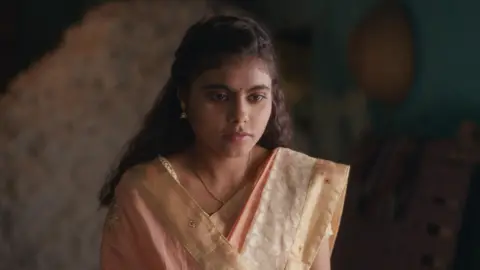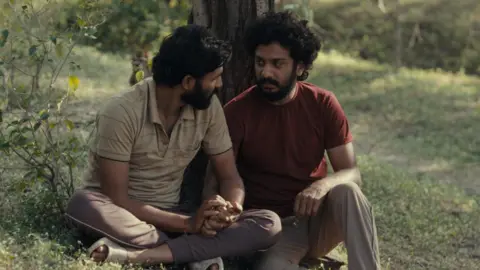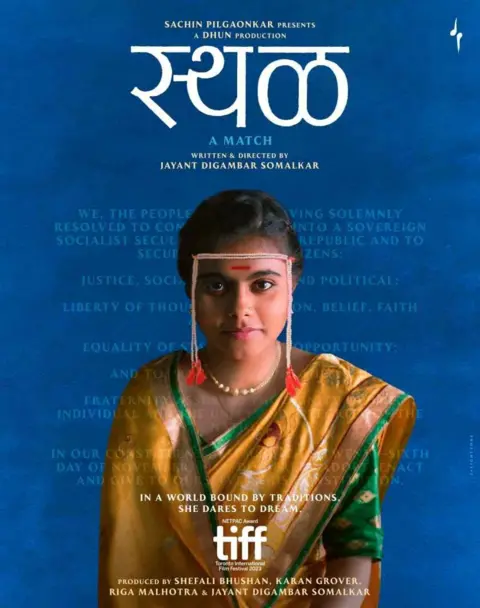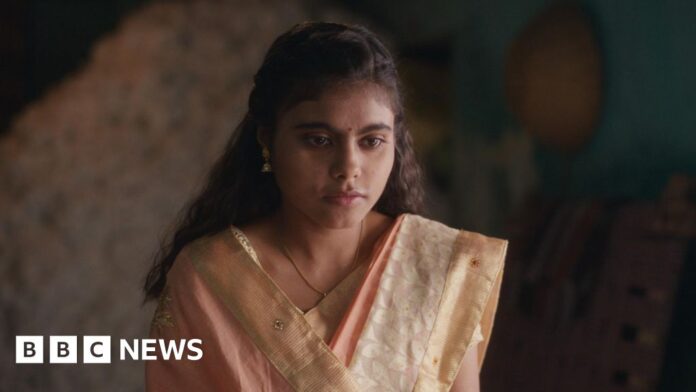 Dhun Production
Dhun ProductionIndia’s first ever silent feature film – Raja Harishchandra – in 1913, was made with Marathi language title cards. Over the past few decades, though, Marathi cinema lost its way, overshadowed by Hindi films from Bollywood. But could a revival be in sight?
The critically acclaimed Marathi language drama Sthal (A Match) opens with a striking role reversal: instead of the bride, it’s the prospective groom who endures the dehumanising ritual of being scrutinised for an arranged marriage.
But we soon learn it’s Savita, the film’s protagonist, waking from an impossible dream – her real life, like that of many Indian women caught in the tradition of arranged marriage, is the exact opposite.
Sthal offers an unsparing look at the grim side of arranged marriage in India—often romanticised on screen with song and dance. It’s also part of a wave of Marathi films earning global acclaim this year.
Sabar Bonda, a semi-personal rural romance between two men, made history as the first Marathi film to screen at Sundance—and won a Grand Jury Prize.
Meenakshi Shedde, a senior programme advisor for South Asian films at the Toronto International Film Festival, called it “a daring, exquisite rural gay romance”, and its bold, tender storytelling “historic”.
 Lotus Visual Productions
Lotus Visual ProductionsOnce pioneers of Indian cinema, Marathi films have long been hurt by Bollywood’s dominating influence in the state of Maharashtra – where the language is spoken – and elsewhere in the country. But in the past decade, they’ve been quietly making a global mark, with diverse, acclaimed titles lighting up international festivals.
Nagraj Manjule’s romantic-tragedy Sairat was picked up for Berlinale in 2016. A few years later, Chaitanya Tamhane’s The Disciple became the first Indian film to screen in Venice since Mira Nair’s Monsoon Wedding – Oscar-winner Afonso Cuaron came on-board as its executive producer.
At least a dozen other independent and experimental Marathi films have since found a spot at global festivals, handling an impressive diversity of subjects.
Harshad Nalawade’s Follower, which was selected for the Rotterdam Film Festival and had a limited theatrical release for instance, dives into the radicalisation of India’s youth, exploring the life of a small-town troll with compassion.
In Second Chance, a black-and-white debut by Subhadra Mahajan, a woman’s post-trauma journey leads her to the Himalayas. Premiered at Busan, it hits Indian theatres this June.
With strong roots in Marathi literature and theatre, including experimental theatre, Marathi cinema has always produced strong films, Shedde says.
Many of the independent films offer “quiet spaces for reflection” she adds, unlike the bombastic commercial appeal of Bollywood.
The aesthetics of this cinema reflect the often marginal backgrounds of its makers – many are self-taught and outside traditional power circles.
Take Sabar Bonda director Rohan Kanawade, for instance – he grew up in Mumbai’s slums but dared to dream of making films.
“This brings a rich, unschooled, rawness and lived experience to their cinema. They are very different from the smooth universal polish of films that tend to come out of international script labs and international co-productions,” Shedde says.
 Getty Images
Getty ImagesBut unlike the steady stream of content from other regional cinema – such as Malayalam films from Kerala – Marathi films still emerge in bursts.
That’s partly because there’s no institutional support, says Shefali Bhushan, Sthal’s producer, who, along with three other partners, put their own money to finance the film.
The big studios don’t pick-up Marathi projects without an “obvious commercial appeal”, which means an ecosystem supportive of experimental artistic voices is sorely lacking, she adds.
Unlike Kerala, Maharashtra also offers little state support for regional cinema and lacks a strong movie-going culture.
Being centred mainly around the cities of Mumbai and Pune, Marathi films “feel the full, suffocating weight of Bollywood, that other regional cinemas don’t”, says Shedde.
Besides, Maharashtra does not have Kerala’s highly “cine-literate audience” where “rice farmers discuss [legendary filmmaker Sergei] Eisenstein and his legacy”, giving those filmmakers confidence that their small indie film can recover costs and make money, she adds.
 Dhun Production
Dhun ProductionThe makers are also to be partially blamed, says veteran film critic Ashok Rane, who was tasked by the state government to market the region’s films at Cannes in the last decade.
They’ve done little to explore subjects that “speak a universal language” and would appeal to the global audience, Rane told the BBC.
Shedde says the industry’s growth has also been stymied by the “lack of aggressive ambition” and the absence of a film distribution system meant that, for decades, India was the “graveyard of good cinema”.
However, she believes international recognition at festivals such as Sundance and Cannes will help to address this – especially for Indie filmmakers wanting to expand to non-traditional markets.
Bhushan agrees – the chance to show her film at Cannes, facilitated by the Maharashtra government, has opened new doors.
She says the festivals are “a chance to learn how to make sales to different territories, mount new projects as co-productions with people [from around the globle]”.
“There’s a whole world waiting to be tapped.”
This report described Raja Harishchandra as the first film made in the Marathi language, and said The Disciple won the best screenplay award at Venice. These inaccuracies have been corrected.


